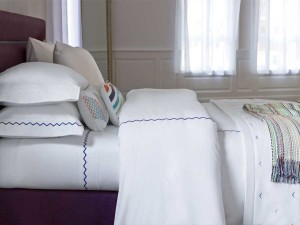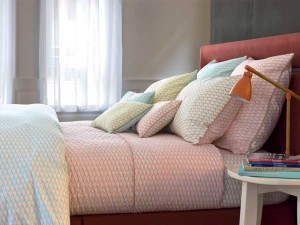Between the Sheets
27 Sep 2015
There are many options when it comes to buying sheets. Here are some terms to help you sort out the best sheet for you.
By Carol Brock When buying sheets, we often just pick ones that fit our mattress. But there’s more to buying sheets than choosing between a twin, full, queen or king. Here are things to consider so you don’t get short-sheeted in the bedding department.Threads Gone Wild
A sheet’s thread count refers to its number of vertical and horizontal threads per square inch. In the U.S. market, thread counts have inched higher until now we see sheets with 1,000 or greater thread counts. But those numbers don’t necessarily translate to a softer sheet. In order to achieve very high counts, some manufacturers use shorter, thinner threads and then twist the yarns together to get a higher number of threads per square inch. Many consumers believe a higher thread count means a sheet with a softer feel or “hand,” but that isn’t the case with sheets woven from short fibers. “A 300 thread-count sheet woven from long-staple Egyptian cotton is far superior to a 600 thread-count sheet woven from shorter cotton and twisted thread,” says Rosella Louis of The Brass Bed, Fine Linens & Furnishings in Denver. “The hand and durability are so much better with a long, single, high-quality cotton fiber.” What you are weaving is the most important thing when determining quality and hand, she adds, which brings us to fabrics.Fabulous Fibers
By far the most common sheet fabric is cotton, with three main types: pima, Egyptian and American upland. Sheets labeled 100 percent cotton are most likely woven from American upland. This cotton is a short-staple cotton, meaning the fibers are short and therefore not as soft as a long-staple fiber. Pima and Egyptian cottons are long-staple fibers, which can be spun into fine, strong weaves that have greater durability and a much softer hand. Long-staple cottons also include Supima, a trademarked name for sheets made with American pima cotton. Combed cotton means the fibers were combed before weaving to remove the short fibers.
Be aware, though, that some sheets marketed as Egyptian cotton may actually contain a low quantity of true Egyptian cotton. If you’re looking for the softest sheets, make sure the label says 100 percent Egyptian cotton.
Today’s sheet market also includes other natural, “fabulous” fabrics, Louis says, including silk, wood pulp, bamboo and linen. Silk is incredibly breathable with a luxurious hand. Wood pulp, a trendy textile in today’s market, is made from sustainable cedar trees. Bamboo is another sustainable fabric that is soft and durable. Linen is a good choice for summer because it’s very breathable, and it absorbs moisture and dries quickly so it retains its coolness. “Linen is very durable and can practically be boiled, and it just gets softer and softer with each washing,” Louis says.
Inexpensive synthetic fabrics, like microfiber and cotton sheets blended with nylon or polyester, tend to be much less breathable and are often thinner, which could make them prone to tears after a few washes.
Pima and Egyptian cottons are long-staple fibers, which can be spun into fine, strong weaves that have greater durability and a much softer hand. Long-staple cottons also include Supima, a trademarked name for sheets made with American pima cotton. Combed cotton means the fibers were combed before weaving to remove the short fibers.
Be aware, though, that some sheets marketed as Egyptian cotton may actually contain a low quantity of true Egyptian cotton. If you’re looking for the softest sheets, make sure the label says 100 percent Egyptian cotton.
Today’s sheet market also includes other natural, “fabulous” fabrics, Louis says, including silk, wood pulp, bamboo and linen. Silk is incredibly breathable with a luxurious hand. Wood pulp, a trendy textile in today’s market, is made from sustainable cedar trees. Bamboo is another sustainable fabric that is soft and durable. Linen is a good choice for summer because it’s very breathable, and it absorbs moisture and dries quickly so it retains its coolness. “Linen is very durable and can practically be boiled, and it just gets softer and softer with each washing,” Louis says.
Inexpensive synthetic fabrics, like microfiber and cotton sheets blended with nylon or polyester, tend to be much less breathable and are often thinner, which could make them prone to tears after a few washes.
What’s in a Weave?
Sheets have certain characteristics according to how they’re woven. For instance, percale and sateen sheets are cotton sheets that have different weaves. Percale has a simple one-under, one-over weave that results in a matte appearance and a sturdy, breathable sheet. “A great percale sheet will be crisp and cool, and still very soft and luxurious, but without any sheen,” Louis says. A sateen weave is one-under, five-over, which gives the fabric a soft, lustrous, silky feel with a visible sheen. “A sateen woven sheet is not hot by any means, but it’s not as cool as a percale, because the air circulation occurs every five rows instead of every single row,” Louis explains.
Which sheet you choose depends on your preference, but keep your body heat in mind. Do you throw off the sheets because of hot flashes or night sweats, or do you constantly pull them around you to stay toasty?
“The typical rule of thumb is percale and linen are more for people who run warm,” Louis says. “Sateen, silk, wood pulp and bamboo are for those who run cool.” And, of course, flannel sheets are a must-have in the winter.
Other things to keep in mind are the sheet’s laundering needs; your mattress depth (so you have enough pocket on a fitted sheet); and the length of the sheet (so you have a generous fold back). Consider if you’ll need a bed skirt, and check to see if any chemicals were added to the sheets to make them wrinkle free or feel softer (natural-fiber organic sheets are free of chemicals). If you want a fancier look, consider sheets and pillowcases with decorative hemstitching or embroidery.
White and ivory will complement any décor, but don’t be afraid of color in your boudoir. “This is weird,” Louis says, “but I always think of what colors make me happy and look good on me when I buy bedding. I want to wake up to a color that makes me look and feel good.”
A sateen weave is one-under, five-over, which gives the fabric a soft, lustrous, silky feel with a visible sheen. “A sateen woven sheet is not hot by any means, but it’s not as cool as a percale, because the air circulation occurs every five rows instead of every single row,” Louis explains.
Which sheet you choose depends on your preference, but keep your body heat in mind. Do you throw off the sheets because of hot flashes or night sweats, or do you constantly pull them around you to stay toasty?
“The typical rule of thumb is percale and linen are more for people who run warm,” Louis says. “Sateen, silk, wood pulp and bamboo are for those who run cool.” And, of course, flannel sheets are a must-have in the winter.
Other things to keep in mind are the sheet’s laundering needs; your mattress depth (so you have enough pocket on a fitted sheet); and the length of the sheet (so you have a generous fold back). Consider if you’ll need a bed skirt, and check to see if any chemicals were added to the sheets to make them wrinkle free or feel softer (natural-fiber organic sheets are free of chemicals). If you want a fancier look, consider sheets and pillowcases with decorative hemstitching or embroidery.
White and ivory will complement any décor, but don’t be afraid of color in your boudoir. “This is weird,” Louis says, “but I always think of what colors make me happy and look good on me when I buy bedding. I want to wake up to a color that makes me look and feel good.” 











